Between 2012 and 2023, the number of fitness businesses in the US increased by nearly 30%, hitting more than 115,000 this past year. In 2021, the fitness industry was valued at $35 billion, and today, the fitness industry is booming, with more and more people investing in their health, wellness, and longevity.
If you are interested in turning your passion for fitness into a career, now is the time. In this article, we explore 10 business ideas for fitness professionals or enthusiasts—ranging from opening a gym to posting educational materials online. We cover examples, the necessary tools and/or accreditations, pricing, and earning potential for these fitness business ideas.
1. Host Bootcamps
A bootcamp is a type of group workout typically involving a series of group classes focused on one goal, like fat loss or strength, with the same set of people. Rather than a membership, bootcamps sell as a single package that includes all the classes in the camp or series. Additionally, bootcamps often take place in public parks, athletic facilities, and other rentable places that are large enough to host your activities.
For example, Burnout Bootcamp in Belmont offers 45-minute bootcamp-style class series targeting different fitness goals.
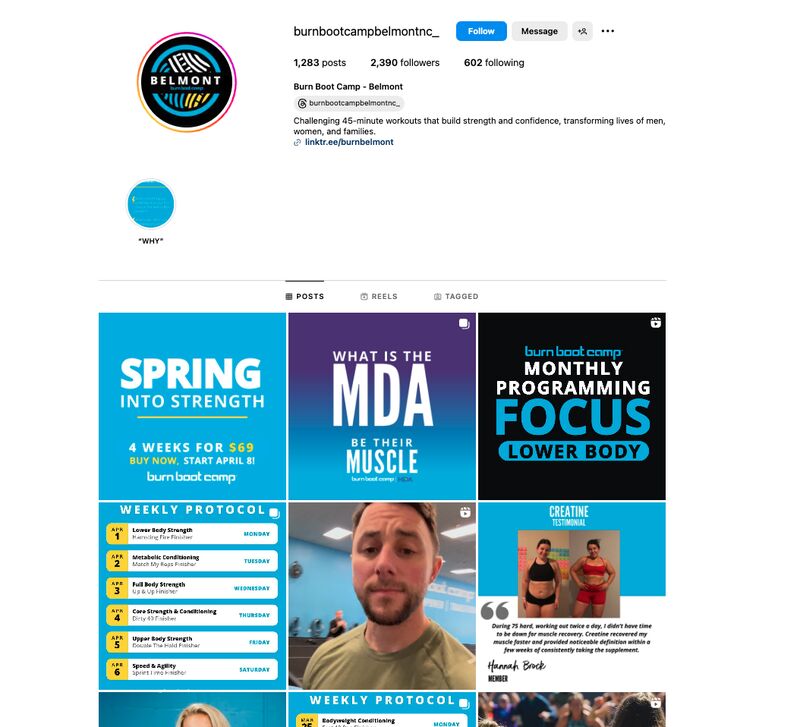
Burn Bootcamp in Belmont, North Carolina, offers weekly programming for 45-minute group classes that are designed to inspire people to get stronger and become their best selves.
Initial Investment: Low to Medium. This depends on the equipment you need and your facility. Some types of workouts, like Pilates or strength training, require accreditation as well. You may also need to secure insurance for fitness professionals.
Pricing: $30–$300 (depending on number of classes and overhead costs)
Earning Potential: Medium. Bootcamps are scalable and ensure a set amount of revenue, but classes that require equipment will have to scale their equipment as their classes grow.
2. Open a Gym
Another fitness business idea you can try is opening a gym. In general, there are two types of gyms—class-based and open-access. In a class-based gym, you provide a facility to host classes, but there is no open access to your equipment. Think gyms like Soul Cycle or Orange Theory. People typically buy class packs in class-based gyms, rather than a membership; however, you will often find “unlimited classes” as a package option.
For open-access gyms, you provide a facility with equipment. People buy a membership, typically monthly, and can then use your facility as they wish. Sometimes, there are even class offerings included in the gym membership. An open-access gym would be something like Planet Fitness or Equinox.
A great example of a class-based gym is Fit Flex Fly in Indianapolis. F3 hosts HIIT, yoga, personal training, and spin classes in their facility. People can buy single classes or class packs, sign up, and come and get a good sweat. The workout equipment, however, is not open access and you must be working with an instructor to use it.
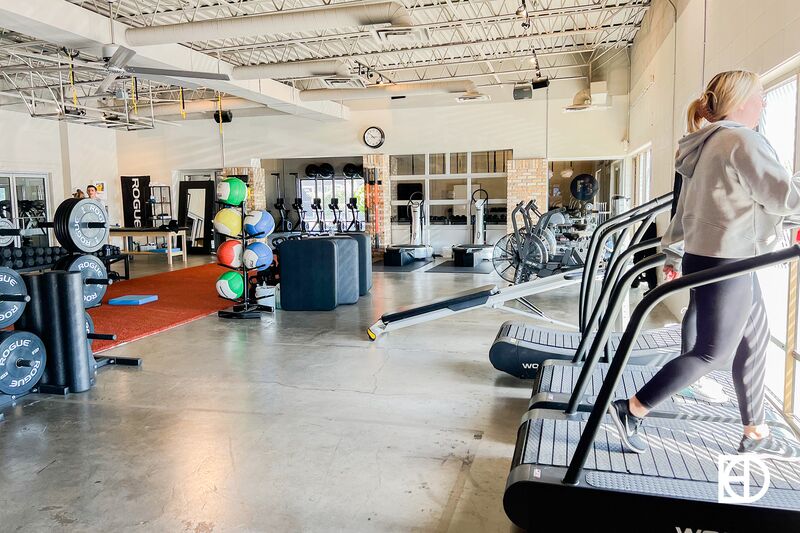
Fit Flex Fly offers a class-based gym for Hoosiers looking to get in shape. (Source: Dwellane)
Initial Investment: High. You will need to acquire a facility, equipment, staff, and gym insurance. Depending on the types of classes offered, you will also need accreditations.
Pricing: Memberships typically range from $40–$200 per month. Classes typically cost between $10–$30 per class.
Earning Potential: Medium to high. While the initial investment is high, once you are set up, ongoing costs are not especially high—think paying staff and performing maintenance. Membership and class pack sales are lucrative and ensure revenue.
3. Provide Nutrition Coaching
You can also try nutrition coaching. If you are a certified nutrition coach, you can get clients and guide them through their nutrition goals, whether fat loss, athletic performance, lowering cholesterol, improving habits, etc. Nutrition coaches will either have a specific niche regarding the types of goals and clients they cater to or offer blanket nutrition coaching for all kinds of clients.
For example, Lauren Carpenter, a nutrition coach based in Denver, aims to help women build muscle and improve their habits to boost wellness and longevity. She built her business on Instagram, finding clients and offering personal fitness and nutrition plans to help them reach their objectives.

Lauren Carpenter got her nutrition coaching certifications and launched her nutrition services on Instagram.
Initial Investment: Low to medium. To be a certified nutrition coach, you will need to get accreditation, which ranges $300–$2,000, depending on the program.
From there, costs are very low and rely on you making your own materials for clients and meeting with them one-on-one. Some nutrition coaches get an office space to host their client meetings, but this is not necessary, and it is common to meet in public places or virtually. The only other additional investment you might need is a booking and informational website, which can be done for free or at a low monthly cost.
Pricing: $50–$90 per hour
Earning Potential: High. Nutrition coaching scales with little to no additional monetary investment. Once you have a book of clients, you typically get a consistent flow of income, and marketing your business to help it grow can be done almost entirely on social media.
4. Launch a Fitness App
When the world was forced away from the gym and into their homes to do workouts in 2020, a new fitness business model came onto the scene in a big way—the fitness app. With fitness apps, people either buy the app or subscribe to a monthly membership. From there, they can access all the app’s services, whether recorded or live workout videos, guided meditations, or other fitness tools.
For example, the ORRO app, launched by the owners of the @sweatsandthecity, a popular fitness influencer page, costs $19 per month to access. The app includes workout classes from the influencers’ favorite instructors, meditations, workout plans, and livestream classes.
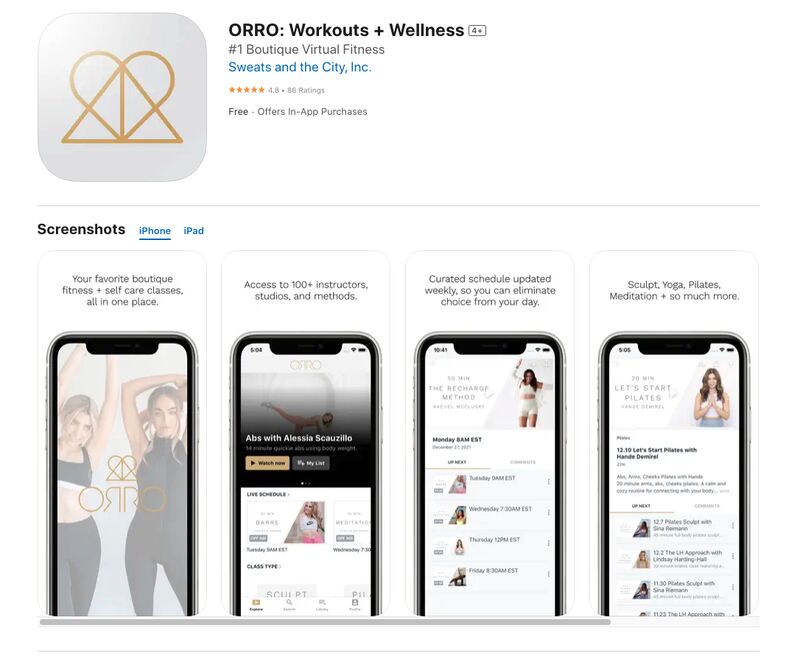
With their loyal Instagram following ready to join their community, the Sweats in the City girls launched a fitness app with workout classes and wellness resources vetted by them.
Initial Investment: Low to medium. You just need to create your app, which can be done for under $100, depending on the platform. From there, you just need to add content, which can mean hiring professionals, using professional camera equipment, and renting a studio space, or just shooting using your iPhone in your home.
Pricing: $0–$30 per month. $6–$18 for app purchase.
Earning Potential: High. The amount you need to invest does not increase as your subscriber base grows. The only ongoing costs you will incur are for maintaining your app and creating new content. As your subscriber base grows, you will also have the ability to collect ad revenue.
5. Arrange Wellness Retreats
Another popular fitness endeavor that you can turn into a business is wellness retreats. This involves creating a multiday program, including housing and food, with wellness classes and activities scheduled for attendees. Typically, wellness retreats will include a Group of Five to up to 100 people gathering for three to 10 days around some collective wellness goal or practice. The only thing not covered by the wellness retreat provider is transportation to the retreat destination; however, you will find services that bring attendees from the airport to the retreat center.
Take Rythmia, a wellness retreat in Costa Rica, for example. It has a small resort where participants can stay, along with programs “designed to accelerate self-discovery and growth and provide participants with the crucial tools to interpret and understand their experience for a more present and purposeful life.”
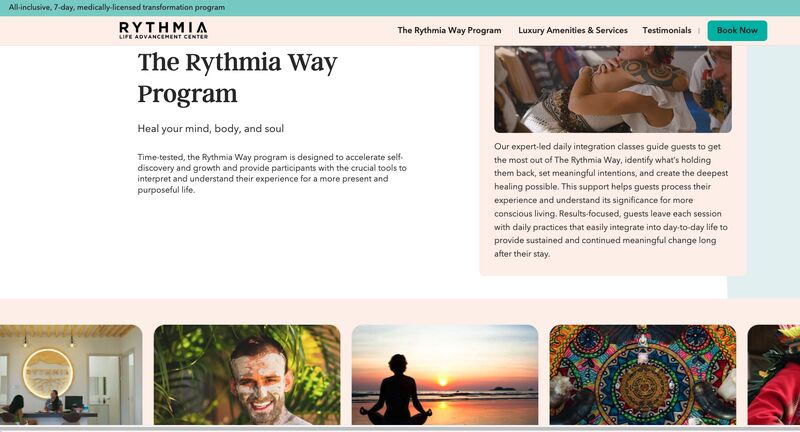
Rythmia hosts health and wellness retreats in Costa Rica with all-day programs and all-inclusive packages.
Initial Investment: High. Wellness retreats need a facility that can accommodate overnight guests and kitchens for preparing food. The facility also needs space to host retreat classes and activities. Then, there are staff and equipment costs.
Pricing: $2,000 – $15,000 (depending on duration and amenities)
Earning Potential: Low to Medium. While you can scale a wellness retreat by getting a steady flow of attendees, overhead costs for food and staff will also increase as traffic does. Additionally, your retreats will be capped at a certain size unless you can get the capital to grow your facility. It is also difficult to get a loyal customer base—you will typically see only one-time visitors.
6. Become a Sports Conditioning Coach
Another type of fitness business is sports conditioning coaching. Rather than wellness or aesthetic goals, sports conditions focus on athletic performance for an athlete’s unique sport. Sports conditioning can be done one-on-one, with several athletes from the same sport, or with a sports team.
It can be offered through a sports conditioning gym, as in the case of Cooper Performance, and clients buy a series of classes. Or, sports conditioning coaches are hired at schools, sports facilities, or class-based gyms to offer coaching services as part of the staff.
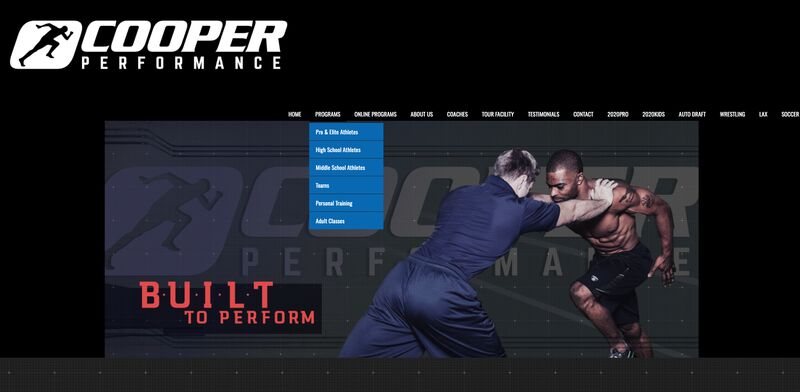
Cooper Performance works specifically with athletes to target athletic, rather than aesthetic or wellness goals, allowing them to capture a different market.
Initial Investment: Low to High. If you plan to open your own gym, the initial cost will be high as you will need to find a facility, equipment, insurance, and marketing materials to attract clients. If you are hired on to an existing business, however, your costs will be low—all you will need is your National Strength and Conditioning accreditation, which ranges from $300–$500.
Pricing: $40–$80 per class
Earning Potential: Medium. If you have your own business, you can scale with more coaches as your client base grows, but you will be limited by time and equipment/space. Additionally, your overhead costs will increase as you add more coaches. If you are a staff conditioning coach, you will likely be salaried.
7. Try Virtual Personal Training
Another route you can take to start a business in the fitness industry is offering virtual personal training. Typically, you will have clients fill out an online form with their fitness goals and current capabilities. Then, you will meet with the client and provide them with training plans. You might even join them virtually in their workouts and coach them through their sessions. You and your clients will then meet regularly to continue to evaluate goals and create fitness plans.
Kortni King, pictured below, is a fitness influencer who started to offer personal training services. Clients simply sign up online and meet with Kortni, and she provides them with plans and guidance to meet their fitness goals.
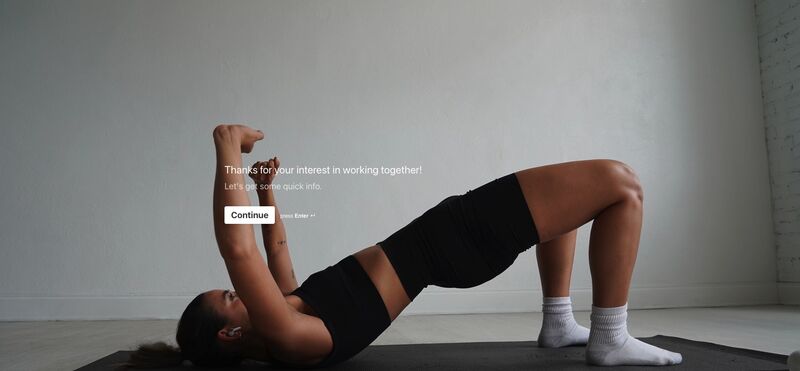
Kortni King created an online personal training program where people can sign up for her services online to receive one-on-one training, weekly plans, and personal guidance—all over the phone and Zoom.
Initial Investment: Low. All you need is a website where clients can sign up and pay for your services and your personal trainer accreditation, which ranges from $300–$1,200.
Pricing: $50–$130 per session (including 1:1 meeting and weekly/monthly workout plan materials)
Earning Potential: High. The startup cost is low, growing your client base requires no additional monetary investment, and the only limitation on your growth is time.
8. Create Race Plans
You can also enter the fitness industry by making and selling race plans online. There are millions of runners across the country, and many of them have never had a coach, relying solely on online materials to help them reach their goals. If you have experience as a runner, you can easily create plans for different distances and paces that runners can purchase online to guide their training.
For example, elite runners, Josh Muskin and Kevin Love, started the website JMFitness where they have training plans for a variety of marathon, half- marathon, and triathlon goal times. The plans are available for purchase and there are free supplemental materials on the site as well.
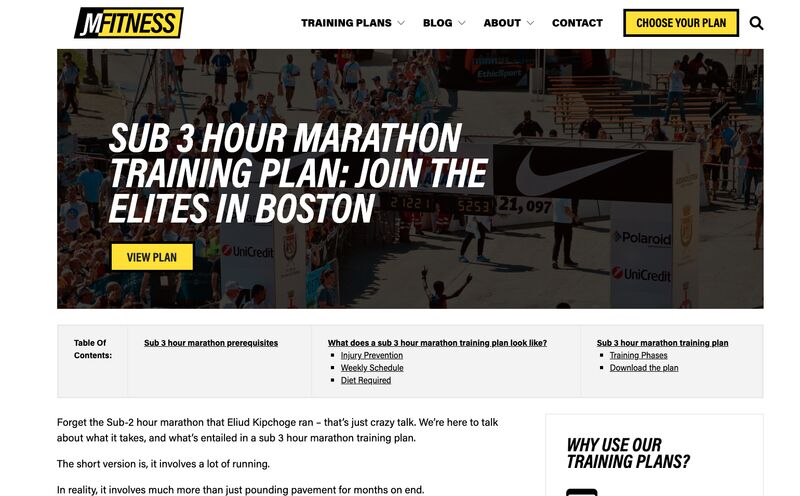
Josh Muskin leveraged his running knowledge by creating marathon plans for various time goals that people can purchase from his website, JMFitness, to help them reach their goals.
Initial Investment: Low to Medium. You will likely need a website to list your race plans for purchase, which can cost as little as $0, depending on the platform you use. You may also be required to purchase general liability insurance and other coverages.
Pricing: $20–$100
Earning Potential: Medium to High. This fitness business model has low initial investment, minimal ongoing costs, and limitless potential for growth. However, it will be difficult to make large profits unless you get a large client base.
9. Sell Workout Apparel
Another way that you can delve into the fitness industry is by selling workout apparel. Workout apparel is very inexpensive to make and people are willing to pay premiums for good designs. There are a variety of ways you can sell your products—online, in your own store, at another person’s retail business or gym, or a combination of all these channels.
For Skatie, a workout apparel brand started by two friends, it started by selling its goods online and at a few local retail locations and has now expanded its brand into swim and even apparel.
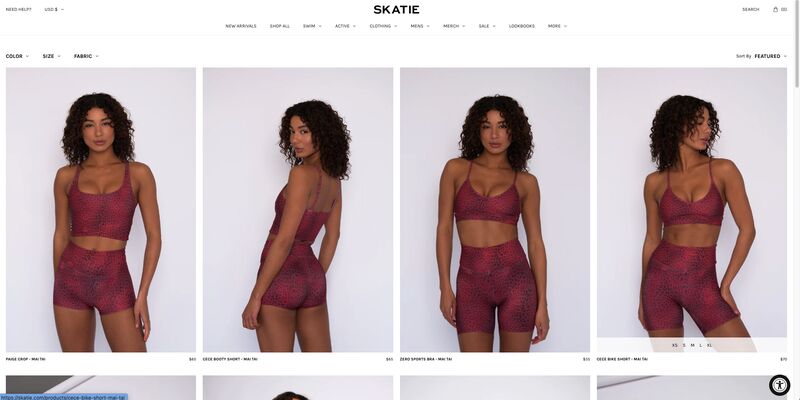
Two friends, Skatie and Mandi, started their activewear brand in 2016 from their living room via Instagram, and now operate a successful business and sell their clothes with major retailers.
Initial Investment: Medium to High. You will need to work with a supplier to create your designs and order products to sell. If you are planning to open your own retail store, you will also need to rent a space and outfit it for your needs.
Pricing: $40–$110 per piece
Earning Potential: Medium to High. As far as apparel goes, activewear has some of the best margins and can be manufactured on a tight timeline. The scale of your business is also nearly limitless, as long as you have space to store your inventory. The difficulty, however, is in penetration. The workout apparel industry is highly saturated, so finding a way in and getting a loyal customer base can be challenging.
10. Become a Fitness Influencer
You can also turn yourself into a fitness influencer. Essentially, fitness influencers create workout and nutritional content and post it online for people to see and engage with. Fitness influencers provide educational materials, inspiration, and/or entertainment that translates to followers and engagement. From there, fitness influencers get brand deals, which is where they make their money. Alternatively, fitness influencers will create their own products, like fitness plans or apparel once they have a following.
For example, Annabelle Ronnfeldt turned her daily practices around fitness and nutrition into content, has gained hundreds of thousands of followers, and now gets brand deals with major fitness brands. She has even started offering her own workout plans for her followers to purchase.
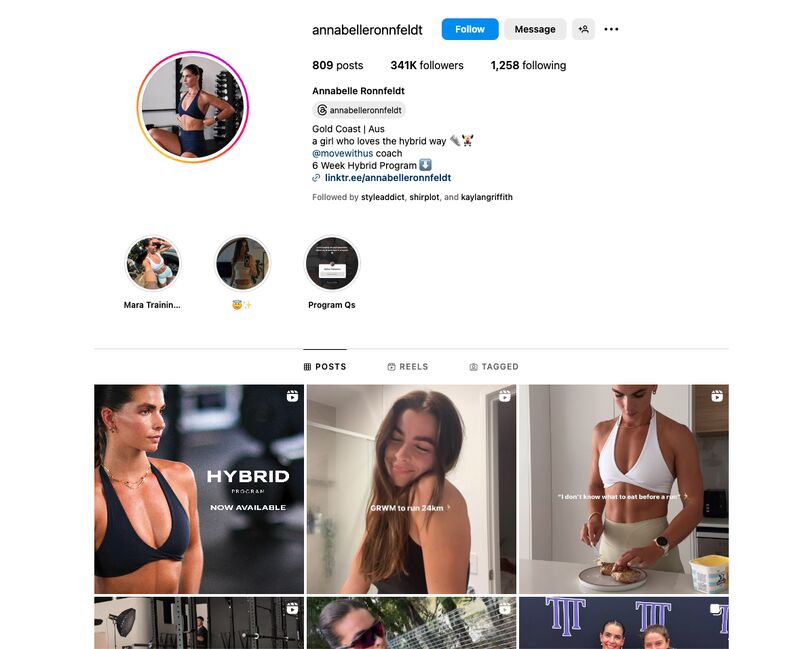
Annabelle turned her personal fitness journey into content and gained followers, sponsorships, and even the ability to launch her own fitness program.
Initial Investment: Low. All you need is your social media page and a camera to shoot your content.
Pricing: Brand deals can range from $0 + some free product to tens of thousands of dollars for a sponsored post. Rates vary based on follower size, engagement, and brand budget.
Earning Potential: Low to High. While you will likely start out doing a lot of work for no return, as your following grows, your earning potential is nearly unlimited. Startup and ongoing costs are minimal to none.
Frequently Asked Questions (FAQs)
Click through the questions below to get answers to some of your most asked fitness business questions.
Fitness businesses range in price depending on the materials you need. For example, starting a fitness app can cost as little as $0, but opening a gym will be much more expensive as you will need to acquire a space, equipment, and staff.
The most profitable type of fitness business scales with limited additional investment, requires no equipment, and has a steady flow of revenue. This typically looks like a subscription-based virtual offering, like a fitness app, virtual training, or online fitness resources.
First, you decide what type of fitness business you want to start, then collect the necessary investment to buy the tools and space you need, market your business, get clients, and scale from there.
Bottom Line
The fitness industry is a booming one, ripe with money-making potential. You can take many different directions when starting a business in the fitness industry, with varying degrees of investment, earning potential, and growth opportunities.
The list of fitness business ideas above, along with information and insights on how those ideas should pan out and examples of where they have been successful, can help you get started on the right foot. With a plan in place, you’ll be ready to turn your fitness business idea into a reality and watch the money roll in.